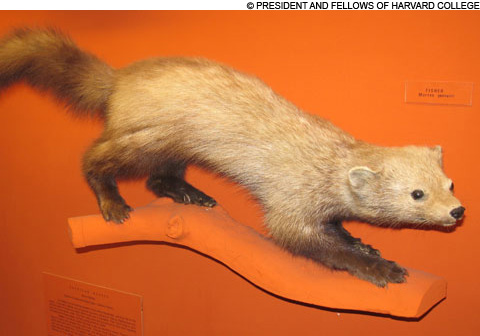
|
The fisher perches in his case, between a black bear and a porcupine. His spine is permanently kinked in an S-curve, his tail cocked, his body no bigger than two paper-towel tubes soldered end-to-end. He is covered in lustrous, if bristly, fur. His mouth gapes slightly, his glass eyes cast plaintively upward. An exposed seam runs from his lower jaw to the visible portion of his solar plexus.The fisher, a cousin to the weasel, lived at the turn of the 20th century, in a wood around Tupper Lake in the Adirondacks. He foraged for fruit and carrion along the forest floor. He spent his twilights hunting for hare, and killing porcupines by biting them in the face until they slowly bled to death.
Around 1921, he was captured, killed, stuffed, and mounted by one of the era's great naturalists. He arrived at his final home, the Harvard Museum of Natural History, just as an enterprising curator decided to enliven the displays by painting them the color of Fiestaware. Thus, for 90 years — through wars and recessions, television and Twitter — the fisher has resided in a glass cabinet, pegged to a board on an uncannily orange display wall.
In that time, the fisher population of the Northeast waned and waxed. Taxidermy went in and out of fashion. Ideas about museums changed, too.
Two years ago, the HMNH's head of exhibition planning and interpretation, Janis Sacco, got the idea for a new kind of exhibit. She wanted to use modern technology to highlight the ecology of a changing local wilderness. It would be a interactive exhibit that incorporated the museum's extant collection — one that would give fresh life to the century-old taxidermy mounts gathering dust against their garish backdrop.
A team of taxidermists from Missouri descended upon the museum. Chase Studio, a company that designs and fabricates natural-history exhibits, vacuumed and groomed the specimens. They airbrushed the skunk and touched up the possum's nose and toes with baby-pink paint.
The fisher got the works. He was "so bleached out that [he] looked like an albino," says Terry Chase, the proprietor of Chase Studio.
"Usually, what we do is we take water-based dyes and restore them to the original color, but these specimens were so blanched out that they would look strange."
So Judy Chupasko, the curatorial associate and collection manager of the Mammalogy Department, fetched Chase some mint fisher pelts from the museum's collection. They used oil paints to match the color, tinting him a rich brown.
I say "him," but no one knows that for sure. The fisher arrived at the museum sans genitals.